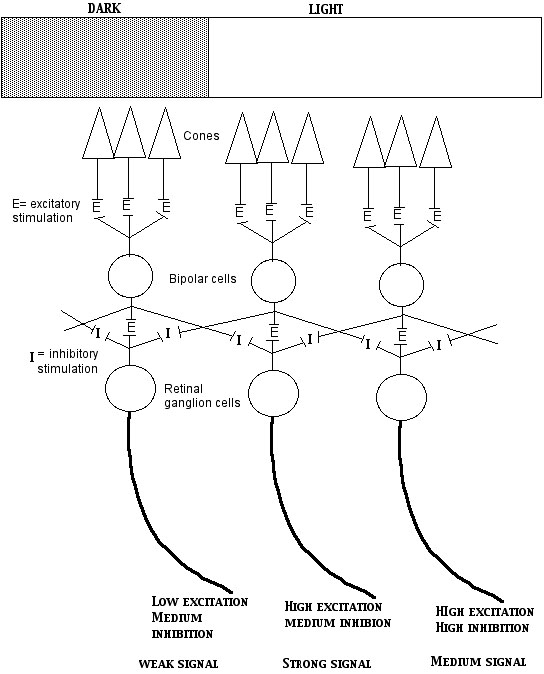The term brightness refers to the perceived intensity of light sources. Intensity (photons/sec) can be measured with a light meter. Brightness cannot be so easily measured. The brightness of a light source will depend on how light or dark adapted our eye is and how wide open the pupil is. We have already discussed the fact that the human eye is a fairly poor judge of absolute intensity. Brightness of a given object is always relative to the brightness of the illumination and other objects in the visual field.
Objects and surfaces reflect light. Surfaces have a quality referred to as "lightness." This is how light or dark we perceive them to be on a gray scale. This turns out to have little to do with how much light is actually reflected from the surface. A black dog looks black in a dark room lit by a candle, but it also looks dark in full sunlight. The light reflecting from the dog in the two situations probably differs by a factor of 100,000 or more. A white dog looks white in both situations as well. Clearly the black dog in bright sunlight reflects much more light than does the white dog in candlelight, yet the white dog looks lighter than the black dog in all conditions.
The sensation of lightness of a surface does not change with the illumination at all. However it does change with the nature of adjacent or background surfaces. The visual system compares the light coming off different surfaces and the sensation of lightness arises from the ratio of light reflected from different surfaces. This makes the sensation of lightness relatively unaffected by the total light intensity or even geometry striking the scene. In general the lightness of an object is a function of how much light it reflects divided by the average amount of light reflected by the objects around it.
Our eye possesses a property known as "lightness constancy". We tend to be able to accurately assess the lightness of objects over a wide range of different illumination conditions. We do this by comparing local surfaces within a scene. We tend to respond to the ratio of light reflected from a given object to the average illumination of all the objects in the scene. Our eye's ability to do this has to do with the way the retina processes information. Uniform lighting causes very little response in our retinal ganglion cells. Each retinal ganglion cell, through its center-surround organization tends to respond to the ratio of light at different locations.
This tendency to compare surface reflection to determine lightness can be fooled. See an example at the following web site. It is shown that the lightness of objects can be altered by the intensity of objects which surround them.
Try the site: Joy of Vision Web book (Copyright © 1996-2002 Peter K. Kaiser. All rights reserved.)The center-surround organization of ganglion cell receptive fields is an example of a more general phenomenon found in the retina: lateral inhibition. Each bipolar cell in the retina receives excitatory input from one or, more often, a group of several cones. This bipolar has an excitatory connection with one ganglion cell. The bipolar cell will also connect to amacrine cells which run across the retina. The connections to these cells is generally excitatory. However the connections of the amacrine cells to other adjacent ganglion cells is inhibitory. This means that excitation of one patch of the retina excites the ganglion cell directly connected to this patch of retina (which means it sends more nerve spikes to the brain), but at the same time it inhibits the response of adjacent ganglion cells (causes fewer nerve spikes). In uniformly lit areas the ganglion cells all tend to be mutually inhibited and give only a modest response. However at edges something different happens. Where the retina is dark little inhibition is sent out to adjacent ganglion cells. The ganglion cells at the edge of a light/dark border that are stimulated by the light put out an excitatory message. They are less inhibited becauses the adjacent cells in the dark are not putting out a strong inhibitory message. The result is an enhanced signal at any edge between light and dark. This is illustrated in the figure below.

Here we show three sets of cones. Each three cones excites
one bipolar cell. Each bipolar cell excites one ganglion cell and inhibits
the adjacent ganglion cells (note -- in the actual retina the inhibition would
involve amacrine and/or horizontal cells, but for simplicity they are not
shown here). As illustrated in the figure, if the three cells are near a light/dark
edge, it is the ganglion cell closest to the edge which gives the strongest
response.
Lateral inhibition explains the phenomenon of Mach Bands. These are illusory darkening and lightening of edges of uniformly lit patches placed next to each other. This is illustrated at the following site: Joy of Vision Web book (Copyright © 1996-2002 Peter K. Kaiser. All rights reserved.)
In summary the main job of the retina is to detect relative
brightness (or lightness) of objects and pick out their shapes by responding
strongly to edges of objects. This is only the first step in visual processing.
The brain must still assign color, shape, depth and distance to these objects,
and it does so with the information provided by the retinal ganglion cells.
Questions:
(1) What does the term "lightness" refer to?
(2) What is lateral inhibition?
(3) How does the eye and brain typically judge how light an object is independent of intensely illuminated the object is?
Last Modified
Wednesday, 22-Oct-2003
fleishml@union.edu